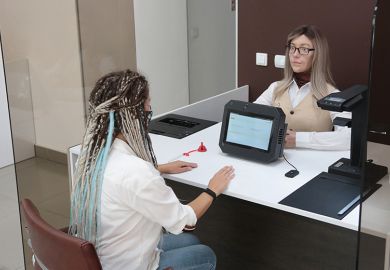In my experience, faculty and administrators alike are by and large risk-averse and generally complacent. As such, the business model of higher education hasn’t changed much over the years, even though the wider world is changing at a rapid-fire pace. Aren’t we supposed to be educating our students on the latest and greatest to prepare them for this world of disruption?
Prior to the pandemic, I experimented with integrating virtual reality (VR) into one of my undergraduate entrepreneurship courses. I teach those students about the lean start-up methodology, which is based on experimentation, iterative learning, pivoting and refinement. You refine your business idea, product or service by testing, getting feedback from customers and other constituents and constantly improving or reiterating. It thus made sense for this to be precisely my approach when introducing VR into my classroom to enhance experiential learning.
I partnered with Lyron Bentovim, CEO of the New York-based Glimpse Group, which is a king among start-ups in the realm of VR. While VR itself is game-changing, if I was going to throw time and resources into this endeavour, it had to add value for my students and significantly enhance their learning experience.
THE Campus resource: Using virtual reality to enhance learning
As such, I chose to create scenarios that students tend to be uncomfortable with, so they could learn and polish their skills in a safe environment − all while learning how to use a revolutionary technology. The Glimpse Group created three simulations for us: a networking scenario, a negotiation scenario and a presentation scenario (specifically to pitch business ideas in front of a large audience).
The cool factor was off the charts, the learning experience engaging, but what was really beneficial was students being exposed to this new world of VR.
How could they use this tech to address problems in our world? One group of students presented an augmented reality platform to help kids with autism. I was left imagining the countless ways that students could interact and collaborate with one another in a virtual world, no matter where they are physically. In the real world, the pandemic has restricted our face-to-face social interactions. In a virtual world, it’s game on.
As the founder and CEO of Edstutia, I’ve heard time and again how university IT departments invest in technology, from software and hardware to new apps, but then grow frustrated because faculty don’t use it. Even with countless workshops and events to educate and inspire faculty to get on board, by and large they remain uninterested.
Students attend university with the expectation that they will learn from experts about the latest and greatest concepts, theories, skills, tools and mindsets. They also, increasingly, attend to become career ready. Where we fall short is that we aren’t teaching and using cutting-edge technology that will give our students a competitive advantage and add value to their professional journeys.
I don’t think it matters what industry students land in, be it fintech, retail, healthcare, energy, sustainability, non-profits − you name it, they need to be well versed in and comfortable with using disruptive technologies such as VR, AR, AI, machine learning, cloud computing and autonomous devices. We are doing our students a disservice by not educating ourselves on these technologies.
When we experimented with VR in the classroom, did we run into tech glitches? Yes. Did it take a bit of time for students to adapt to the sensations and functionality within VR? Yes. Was the experiment perfectly executed? No. But I’m OK with that. That’s the nature of entrepreneurship and a space I am comfortable in.
THE Campus resource: Sparking entrepreneurship online
Experimenting with truly immersive VR is mind-blowing. The possibilities and opportunities are endless. A company like the Glimpse Group can create just about any scenario we can imagine. Why are we not investing more time and resources in such technologies?
Furthermore, dear professors, why are you so hesitant to learn something new? You are educators. Don’t you also love learning? Don’t you love challenging yourself to think in new and different ways? I’m baffled by some of the aversion to 21st-century demands and opportunities.
We can’t keep teaching the same things in the same ways. We can’t continue with the outdated concepts of lectures, textbooks and rote exams. We owe it to our students to be on the cutting edge ourselves. Their future success depends on us preparing them for a fast-paced, tech-driven world.
There is no going back to “how things used to be”. We need to look ahead. We need to embrace the current disruption. We need to enable students to learn and collaborate in new ways no matter where they are in this world. VR is just one technology that can truly make learning come alive. I find it edge-of-my-seat exciting. Who’s with me?
Christine Janssen is a clinical associate professor and the director of entrepreneurship in the Gabelli School of Business at Fordham University in New York City. She is also the founder and CEO of Edstutia.
Register to continue
Why register?
- Registration is free and only takes a moment
- Once registered, you can read 3 articles a month
- Sign up for our newsletter
Subscribe
Or subscribe for unlimited access to:
- Unlimited access to news, views, insights & reviews
- Digital editions
- Digital access to THE’s university and college rankings analysis
Already registered or a current subscriber? Login








